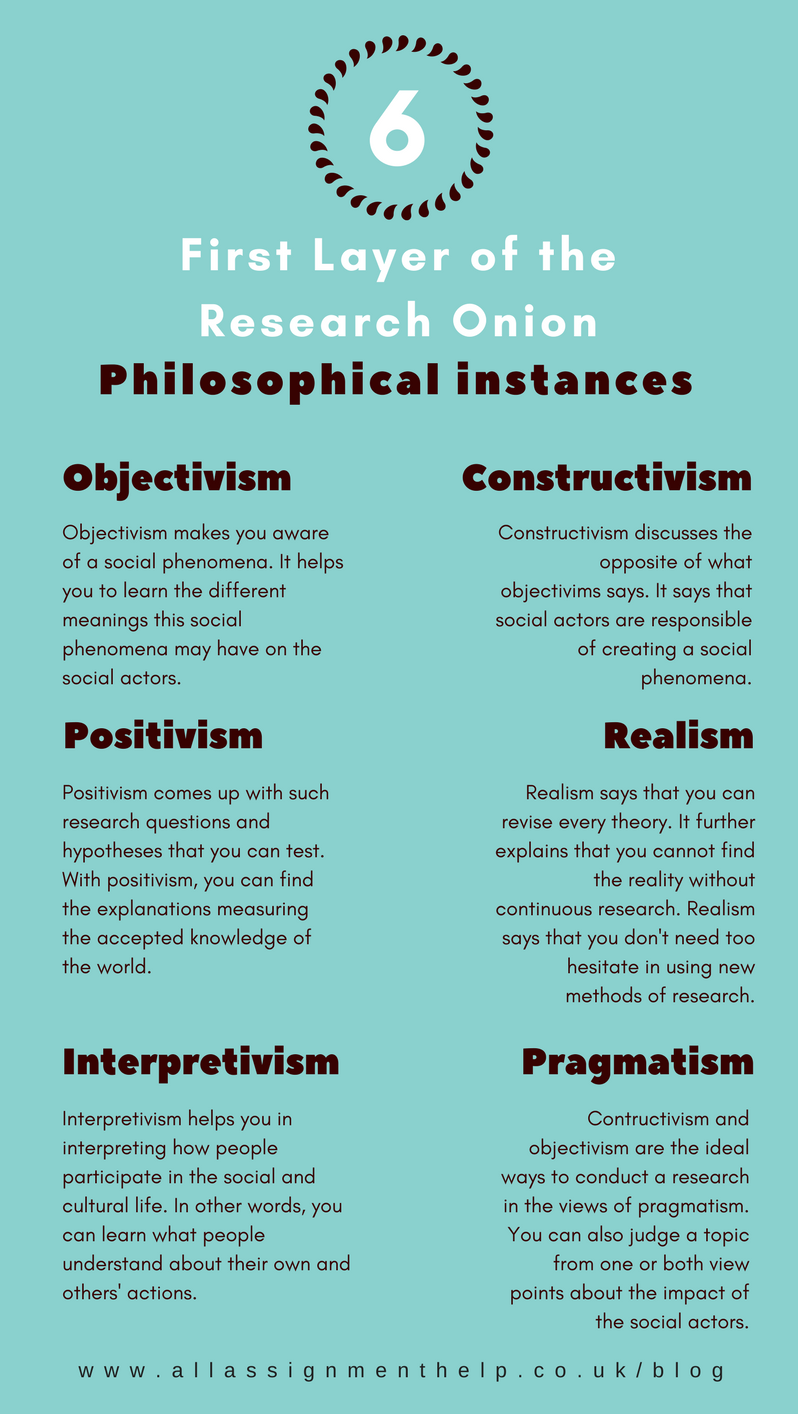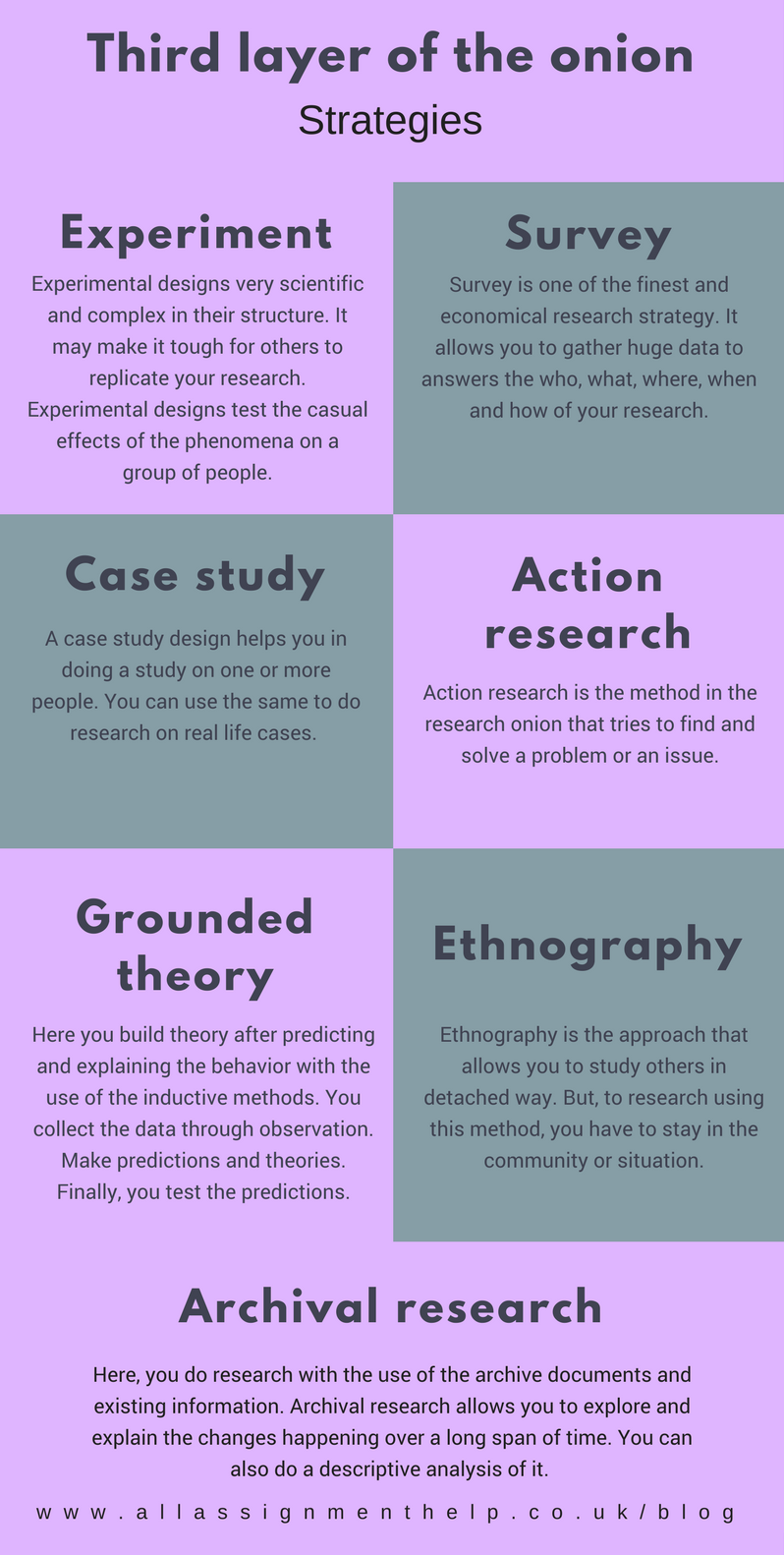You may have to write a dissertation with the use of research onion. This task may seem complex to you if you don’t have the knowledge about it. Thus, here we will share a guide with you that will work as a research onion example for you.

Use of the right philosophy holds much significance in planning and carrying out a research. So, let’s take a look at the philosophies first:
- Philosophy of Ontology
- Philosophy of Epistemology
- Philosophy of Axiology
Now, let’s learn about these three philosophies of research onion thoroughly.
Ontology
This philosophy makes you aware of the nature of reality. You ask yourself different questions while using this research method. You try to find out how the world operates. It also makes you learn the process of the construction of the society. It also helps you in knowing how society impacts our surroundings.
In other words, ontology clears the difference between reality and how you perceive reality. Furthermore, it makes you learn how it influences the behavior of the people. Mainly, three philosophical positions come under the ontological worldview. Those are objectivism, constructivism and pragmatism.
Epistemology
Next research onion philosophy is the epistemology. It tries to find the acceptable knowledge and addresses the facts according to that. Here, you have to define the acceptable knowledge about the field of your research. It is also a must for you to give information you acquired after rigorous testing.
You use epistemology mostly for the scientific research purposes. It is like that because it helps you in finding the information that you can prove without a doubt. Positivism, critical realism and interpretivism are the philosophical positions relate with epistemology. You can learn it to get an in-depth idea of the epistemology.
Axiology
Axiology helps you learn how valuables and opinions impact the collection and analysis of your research. Here, you don’t have to eliminate or balance the impact of it.
First layer of the research onion
Now you are aware of three much-needed philosophies of the research onion. Now let’s move on to learn about the layer one of the onion. In this layer, you can find the philosophical stances associated with philosophies. Here, you have to give appropriate thought to every possibility at this level.
It is because it gives you the structure, guidance and possible limitation to follow decisions. You can also get aware of the ways of gathering and analyzing information to come up with a fine research.
Objectivism
In the research onion, objectivism makes you aware of a social phenomenon. It helps you to learn the different meanings social phenomena may have on the social actors. For example, a sunny day is a social phenomenon. Some people may find it pleasing and others may not.
So, through objectivism, you may learn how a social phenomenon impacts different people.
Constructivism
Constructivism discusses the opposite of what objectivism says. It says that social actors are responsible for creating social phenomena. Hence, you must use constructivism philosophy if you have to research such a topic.
For example, we make laws to stop crime. People are the ones who commit crimes. So, people are responsible for the new rules coming from time to time.
Positivism
Next in the research onion is the positivism. Positivism comes up with the research questions and hypotheses that you can test. With positivism, you can find the explanations measuring the accepted knowledge of the world. An example of it is the law of gravity.
It is the type of body of research that other researchers can also take to find the same outcome. Here, you give importance to get the quantitative results. It may lend you to statistical analysis.
Realism
Realism and Positivism are quite similar. It says that social reality and you are not dependent on each other. It will not let them give biased results. However, realism says that scientific methods are improper. It separates the realism and positivism.
In the research onion, realism says that you can revise every theory. It further explains that you can not find the reality without continuous research. Realism says that you don’t need to hesitate in using new methods of research.
This way realism allows you to use many types of research methods. It will help you to come up with a reliable outcome.
Interpretivism
Interpretivism helps you in interpreting how people participate in the social and cultural life. In other words, you can learn what people understand about their own and others’ actions.
It can help you in understand a culture. Furthermore, you can also learn about the cultural existence and change through learning about the ideas and valuables. Some meanings may also prove helpful for you in the same.
Pragmatism
Constructivism and Objectivism are the ideal ways to conduct a research in the views of pragmatism. You can also judge a topic from one or both viewpoints about the impact of the social actors.
You can use these views to create a practical approach to research. It is essential in the research onion. You can use it to come up with the solution of the problems.
Second layer of the research onion
Deductive and inductive are the two terms that the second layer of the research onion includes. Here, previous levels may influence the decisions that you make on the current level. It is a must for you to discover your research aim and limitations.
Furthermore, you must give a thought to the personal views to find out the best research method for you. Now, let’s take a look at the two essentials of the layer 2 of the onion. It may help you in conducting your research.
Deductive
In the deductive method, your aim is to find the answer to the question that you have at the start of the research. Your premier objective stays to come up with the yes or no answer in response to the research question. Your research questions may vary from statements to informed speculation.
In the deduction process, you scan the theories to the research question. It further leads you to gather data and ultimately the confirmation or rejection of the question. You can do the revision of the theory. Moreover, you can often start the process again.
Inductive
If you want to create your own theory, then you use the inductive method. So, this point in the research onion works in the opposite way of the deductive method. To put it technically, here you focus on the working title of the theory right from the start. It means you don’t need to give a thought to an existing theory.
The hierarchy of the research runs from research question to observation. Next come the observation, description, analysis and you come up with your own theory in the end. Hence, it is better for you to use inductive method for the research if your research requirements are not big.
Third layer of the research onion
We will discuss the third layer of the research onion in this section of the article. So, let’s learn which research methods the third layer of the onion offers you.
You use a research style to gather and analyze data like grounded theory are the choices. Every choice has its benefits and limitations. Thus, it is a must for you to give a thorough thought to each of it. Furthermore, you should explain and balance the choice well in the work.
You have the option to choose more than one of these choices while researching. It is a must for you to justify well in your work.
Experiment
You can find the experimental designs very scientific and complex in their structure. It may make it tough for others to replicate your research. Experimental designs test the casual effects of the phenomena on a group of people.
It comprises the group of people who are not under the effects of the phenomena. You can call the independent variables on the dependent variable as causal effects. Moreover, experimental strategies can give you such data that you can analyze statistically.
Survey
Survey strategy of the research onion is often linked with the deductive approach. It is one of the finest and economical research strategy. It allows you to gather huge data to answers the who, what, where, when and how of your research. You can collect rich and reliable data through this method.
Case study
A case study design helps you in doing a study on one or more people. You can use the same to do research on real life cases. It is a must for you to keep a check on the number of cases to come up with a clear conclusion.
You should gather this type of data while studying a case:
- Take a look at the peoples’ behavior
- Consider the settings
- Interview the people
- and search the records
Action research
Action research is the method in the research onion that tries to find and solve a problem or an issue. An organization makes you part of it if they ask you to do a research for them. In other words, you and the organization work in collaboration on the topic.
In the action research method, you take the following process to do things:
- Have an objective
- Find the diagnosis of the issues
- And make the list of the actions to deal with the problems
Grounded theory
The grounded theory builds a theory after predicting and explaining the behavior with the use of the inductive methods. In this method, you collect the data through observation. Next, you make predictions and theories with the use of this data.
Finally, you test the predictions. Although this theory comes up with new theories, yet is it grounded. It is because of the existing theory and literature on the topic.
Ethnography
You can find the roots the ethnography in the anthropology. Anthropology is the study that allows you to study others in a detached way. But, to research with the ethnography method, you have to stay in the community or situation. You may find this research method time-consuming. It is because things can take time to change or get in your head.
Archival research
Next in the research onion is the archival research. It goes as the name suggests. In other words, you do research with the use of the archive documents and existing information. Archival research allows you to explore and explain the changes happening over a long span of time. You can also do a descriptive analysis of it.
But, it is possible that the information may have some fault. It may lead to your research not reaching anywhere.
Fourth layer of the research onion
So, till now we have discussed the three layers of the research onion. Hope you are understanding it well. Next, comes the fourth layer of the onion. Let’s find out which research methods it offers you.
In this layer, you discover the ways to use quantitative and qualitative methods for the research purposes. Here, you ensure whether both methods are ideal to use or one is fine. Furthermore, you also decide whether use one method more than other. Or the frequency will stay equal.
You cannot find a layer of the quantitative and qualitative research methods in the research onion diagram. Hence, you must give a thought to it continuously while researching. In quantitative research, you consider the quantity and measurements. Whereas qualitative research allows you to explore personal accounts, descriptions and opinions.
You can use three types of methods according to the fourth layer of the research onion diagram. Let’s learn the same below.
Mono-method
In the mono-method, you gather only one type of information from qualitative and quantitative. You may have to do it due to the demands of the philosophy. Philosophical choices and used strategies may also demand it. You can also use this method to research on the opposing view that exists in the mono-method.
Mixed-methods
Next method in the fourth layer of the research onion is mixed-methods. It allows you to use both qualitative and quantitative methods for the study purposes. You can also use the same to gather as well as analyze the data.
It is possible when you combine both these methods, you can offset the limits of these methods. You can find and fill the gaps in the information easily.
Multi-methods
Multi-methods helps you in researching with the use of the qualitative as well as quantitative information. However, your focus stays on the one source only. This way you analyze both types of data, but with the same point of view.
Fifth layer of the research onion
Layer five of the research onion has two-time horizon methods. First is cross-sectional that you can use to conduct a short time study. Another one is longitudinal that you can use while doing a long-term study.
Cross-sectional
You can use qualitative and quantitative research in the cross-sectional method. It may help you in observing the behavior of a group of people or an aspect. You can also use the same method to do study on an individual at one point of time.Longitudinal
Longitudinal
Longitudinal method also allows you to use qualitative and quantitative research methods. But, you use this method to study behavior and events with focused samples over a longer time.
Sixth layer of the research onion
Layer six of the research onion give you a fine idea of the practicalities of data collection and analysis. Here, you have to make a decision of which data may prove best for your research. Moreover, you also have to discover the analysis you have to use to find the desired results.
Data collection and analysis
In this section of the research onion, you decide the questionnaire content and sample groups. You also give a thought to the questions you will ask in the interviews and many others things. It is a must for you to make sure that all the decisions and tools you use sync with the philosophies.
You must keep the same thing in mind for the philosophical stances, strategies, choices and time-horizons. It may help you reach the valid results.
That sums up this article here. Hope it was helpful. You can check out other articles on our blog if you are interested.


